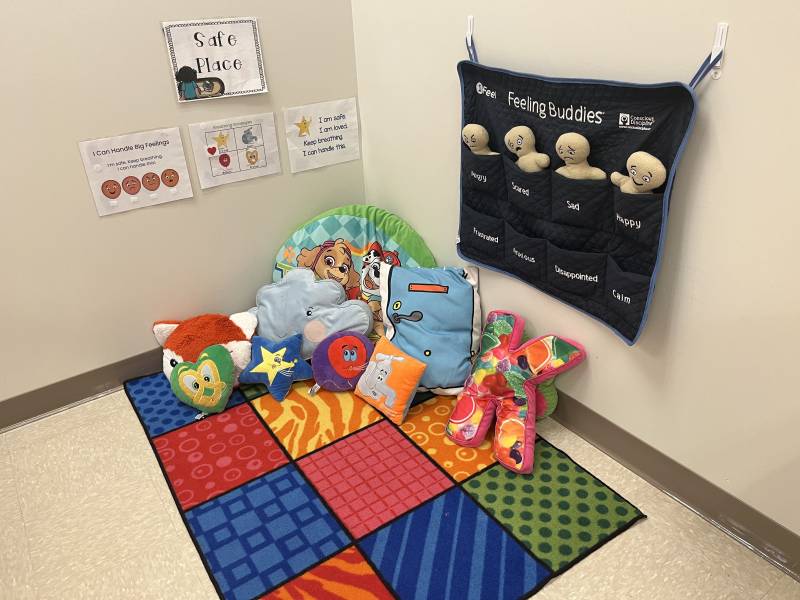After that, each morning Kist guides students through using the different tools in their boxes. They take out a card that has faces for the four basic feelings and mark which feeling they identify with that morning. Then, the children take out their breathing strategy card, which has four different icons that indicate different breathing strategies that they have learned. The boxes also have a card in them that remind the students of what Kist calls “I love you” rituals – nursery rhymes with the lyrics changed and designed to help students with attachment and connection. Students practice an “I love you” ritual one-on-one with a classroom adult each morning.
Kist’s “little safe place” boxes are modeled from the self-regulation and emotional identification tools in the “safe place” corner of her classroom, an area that also contains a rug and pillows to comfort students. In a moment of dysregulation, whether the student is using the box or the safe place corner, a classroom adult can guide them to use these tools to recognize and move through their emotions. Each student also has a family photo in their box. “Connections to home are just so helpful if they’re upset about anything,” said Kist.
Learning to identify emotions
Identifying emotions is a complex process. For young children the first steps in this process are learning to recognize facial expressions, tone of voice and body language, according to Goodwin, the child psychologist. They also need to learn to label those context clues with language.
According to Goodwin, children should be able to identify emotions by around three or four years old. Although most children will learn how to identify emotions naturally through social interaction, parents and educators can facilitate that learning. “The biggest thing you can do is just talk about emotions,” she said. Taking opportunities to talk about and label your own emotions or the emotions expressed in a children’s TV show or book can be helpful. It is also helpful for parents and educators to label emotions that a child is expressing for them so that “in the future they can then learn to label it themselves,” Goodwin said.
To help students build empathy, Goodwin recommends parents and educators ask young children what a character in a book or tv show might be feeling, and why they might be feeling that way. One activity that Goodwin has found useful in her personal and professional life is “feeling charades.” In this game, both children and adults act out a feeling, while the other participants guess what feeling they are expressing. Feeling charades can also be played with puppets or toys.
Learning to regulate emotions
In Kist’s classroom, students practice emotional regulation strategies throughout the day, not just when there’s a peer conflict or an individual child is distressed. “You can’t teach it when they’re in the middle of it,” Kist said. When a child is upset, she takes time to acknowledge the student’s feelings, reflect back to them what their face is expressing and suggest an emotion that they might be feeling.
Kist’s students also practice different breathing techniques throughout the day. Breathing exercises can be helpful for self-regulation, but young children need concrete explanations, so the techniques Kist uses have a symbol, such as a star or a balloon. The visual reminders are printed on a small laminated page in their “little safe place” box. When a student needs to access deep breathing, they can pull out their breathing card and choose an exercise. Kist and her students also make up their own breathing exercises, always involving a physical aspect like deep breathing while swinging their leg to kick an imaginary ball.
Goodwin suggested encouraging children to breathe in through their nose and out through their mouth by pretending to smell a flower and blow out a candle. This can be given as a verbal explanation, but can also be helped by using fake flowers and candles, or even drawings for children to reference.
Goodwin also uses belly breathing, where young children put their hands on their bellies as they breathe to feel how their abdomen expands and contracts with each breath, as well as five-finger breathing, where children trace their fingers on one hand with the index finger on their other hand as they take slow breaths, one per finger. Teaching these techniques can be frustrating because kids at this age are easily distracted and learning these skills for the first time. It “just takes like a lot of modeling,” and “a lot of reminding,” said Goodwin.
COVID-19 origins and ongoing impact
Kist originally created the “my little safe place” boxes when the early learning center went virtual in spring 2020 because of the COVID-19 pandemic. During the unfamiliar experience of virtual learning, she wanted to find a way to provide a portable and accessible version of the safe space corner for each student.
Initially, not every student was given a “little safe place” box. But as she saw how helpful they were to the students that she had given them to during at home learning, Kist decided that every student in her classroom should have one. Since incorporating the boxes in her in-person classroom, she has seen students bring other students their boxes in moments of dysregulation. She has also seen some of her young learners singing their “I love you” nursery rhymes with each other unprompted.

